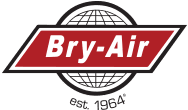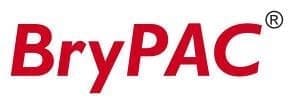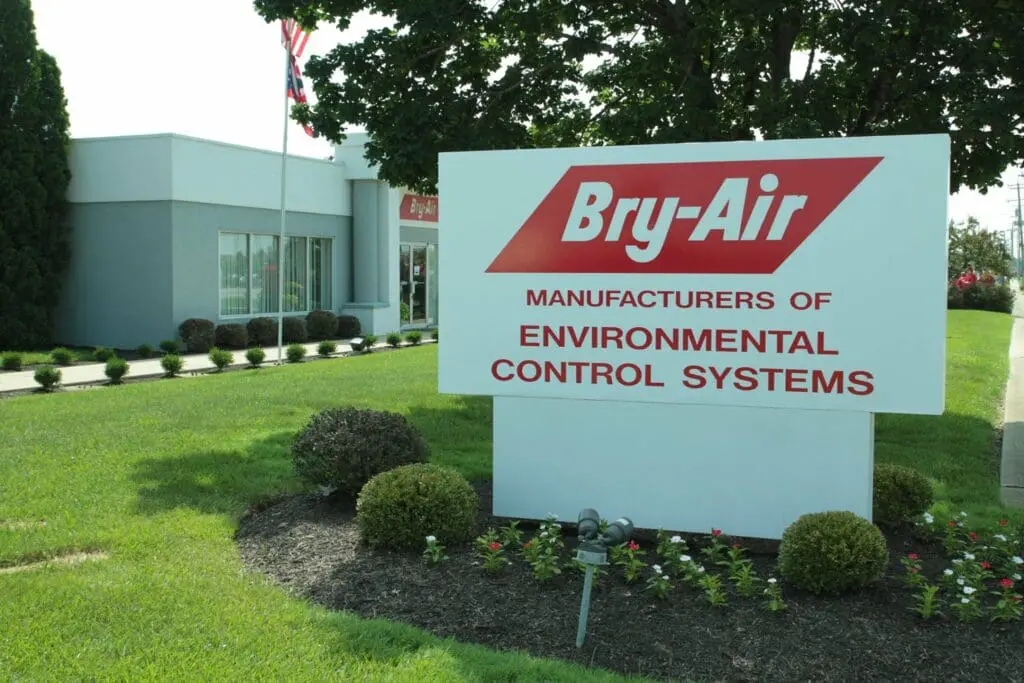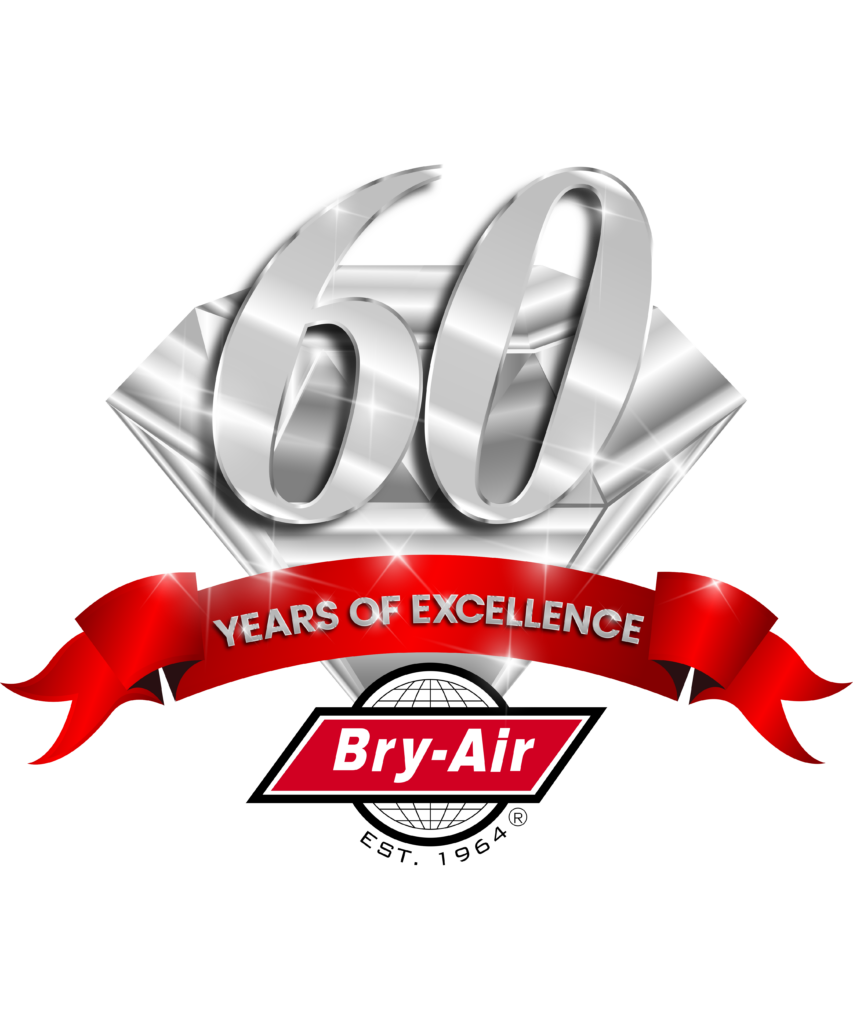Utilities & Temperature Control Solutions
Please make a selection from the tabs below to find additional temperature control information.
Dry bulb, wet bulb, dew point temperature, and relative humidity, these terms are so closely related that if two properties are known, all others shown in the figure below may be read from the chart. When air is saturated, dry bulb, wet bulb, and dew point temperatures are identical. (See Example 2.)
Enthalpy of air for any given condition is the enthalpy at saturation corrected by the enthalpy deviation due to the air not being in a saturated state. The enthalpy (h) in Btu per pound of dry air is the enthalpy at the saturation (hwb) plus the enthalpy deviation (hd). (See Example 2.)
h = hwb + hd
If the air’s moisture content increases or decreases in a psychrometric process, the heat added (q) or removed (-q) is the difference between the enthalpy of the final or leaving air (hla) and the initial or entering air (hea) minus the enthalpy of the moisture (water in liquid or ice state) added (hw) or rejected hw.
q = hla + hea – hw
See Examples 4 and 5.
The enthalpy of added or rejected moisture is shown in the small graphs at the top of the chart.
Enthalpy of added or rejected moisture and enthalpy deviation are usually omitted in applications not requiring precise results – for example, comfort air conditioning. Errors due to omissions for wet bulb temperatures below 32°F are much larger than for omissions above 32°F.
Sensible heat factor. This is part of certain calculations for installing air conditioning equipment. A scale along the right side of the figure in Example 4 below used with an origin at 80° dry bulb temperature and 50% RH provide a reasonable heat factor value. (See Example 4.)
Barometric pressures. In comfort air conditioning, a mercury reading of one inch or less either above or below the standard 29.92 inches of mercury is considered a standard reading.
When dry bulb and dew point temperatures are known for air at non-standard barometric pressures, values of percent RH and grains of moisture per cubic foot are correct on a standard chart, but for given dry bulb and wet bulb readings at non-standard barometric pressures, all properties must be corrected.
Interpreting the Air Conditioning Charts
Generally, in graphic presentations, humidifying is shown by an upward line and dehumidifying is shown by a downward line.
Heating and cooling air without changes in moisture content involve only a change in sensible heat and appear as a horizontal line, to right or left respectively. Changes occur in dry bulb, wet bulb, RH, and enthalpy. Specific humidity and dew point temperature remain constant.
In heating and humidifying, both sensible heat and specific humidity increase – shown as a line sloping upward and to the right. Changes occur in dry bulb, wet bulb, dew point temperatures, and enthalpy. A difference in RH depends on the slope of the line.
Air Conditioning Process
For cooling and dehumidifying, both sensible heat and specific humidity decrease, so the line slopes downward and to the left. Dry bulb, wet bulb, dew point temperatures, and enthalpy all change. Changes in RH are dependent on the slope of the line.
Evaporative cooling refers to air brought in contact with spray water at a temperature equal to the wet bulb temperature of the air. The process takes place upward along the wet bulb line. As sensible heat of the initial air vaporizes the water, the air’s dry bulb temperature falls. The sensible heat used to vaporize the water enters the air as latent heat in added vapor; thus no heat is added or removed. Wet bulb temperature remains constant. Dew point temperature, RH, specific humidity, and enthalpy increase. (In most evaporative cooling installations, heat may be added or removed during the process due to outside sources, although this amount is usually negligible.)
In chemical dehydration, the air that contacts the chemical either adsorbs or absorbs moisture from the air. Thus in this energy constant process, heat is liberated and added to the air and this amount is basically equally to the latent heat of vaporization of the moisture removed. Indicated by a downward sloping line approximating the wet bulb line, the slope of the chemical dehydration line may be either slightly greater or less than the wet bulb line, depending on if heat is stored, liberated, or absorbed.
AIR CONDITIONING PROCESSES such as heating, cooling, humidifying and dehumidifying may be shown graphically on the chart. (See Figure 1.)
A useful tool for finding duct diameter, duct velocity, friction loss and air mixture. Available as Microsoft Excel spreadsheet download.
Typical Dry Air Application Standards
The applications below represent a very small percentage of the needs and uses for dry air; the conditions cited are typical of past uses. Specific needs change, as do technology and manufacturing processes.
Your Bry-Air representative can determine appropriate values for a particular application.
Typical Application Standards | |||
Application | Typical Conditions | Notes | |
Temp °F | Humidity | ||
Aerosols | 80 | 2 gr/lb dry air | Use hood over Freon charging nozzle and purge hood with very dry air |
Brewing and Distilling Hops Storage Fermentation Rooms Filter Rooms Grain Storage | 35 60 | 60%RH 45%RH 45%RH 40%RH | To reduce mold growth on walls To reduce mold growth on walls |
Baking Sugar Storage Icing and Glazing Cookie Drying Filled Cookie Setting Potato Chips | 80 80 65 20-30 75-80 | 35%RH 35%RH 20%RH 20%RH | Dry Air to minimize defrost requirement |
Candy Caramel Cooling Bar Cooling Chocolate Hard Candy Making Hard Candy Packing Sugar Storage | 60 0 90 75 75 80 | 40%RH 40%-50%RH 13%RH 35%RH 35%RH 35%RH | Care should be exercised in the systems design to insure against recirculating air-borne sugar dust in the system |
Concentrates Molasses Grinding Honey Grinding Instant Coffee Packing Citrus Crystal Packing | 80 80 | Less than 25%RH Less than 25%RH 20%RH 15%RH | Do not recirculate – Pre-cool and dry to 20-25 gr/lb |
Ferrous Cupola Dry Blast |
| 40 gr/lb dry air |
|
Crystal Growing |
| Varies | Dependent on particular salt |
Crystal Cutting |
| Varies | Dependent on particular salt |
Coils-Electronic |
| Lowest possible 1-3 gr/lb dry air | Prevent moisture absorption by insulation |
Coils – TV and X-Ray | 72 | 15%RH |
|
Transformer Manufacturing and Rebuilding | 80 | 5%RH |
|
Elec. Appliances | 72 | 15% | In blankets and pads with Nylon sheathing or insulation, moisture causes shorting and change in electrical characteristics and moisture absorbed in sealed sheath heating elements can cause failure and even explosion |
Lightning Arrestor (Assembly) | 60 | 20%RH |
|
Typical Application Standards | |||
Application | Typical Conditions | Notes | |
Temp °F | Humidity | ||
Switch Gear Assembly | 68 | 20-24%RH |
|
Lamination | 80 | 20%RH max | Paper, cloth or wood, glass fibers, etc. bonded with plastic, shellac, varnish or glue. Store material at 20%rh to insure good bond. Store finished goods at less than 80° F at 20%RH to prevent adhesion. |
Chinchilla Raising | 32-35 | 18-25%RH | High humidity is a health hazard. Low temperature and humidity provide denser and better pelts. |
Matches | 70 | 40%RH | For drying |
Paper Coating | 80 | 20%RH | For paper storage prior to coating with wax, plastic, adhesive, etc. To insure bond (See lamination) (Limit paper to 4% moisture) |
Paint Spraying and Lacquering | 80 | 50%RH or less | Control spray booth or cabinet to prevent blushing caused by moisture condensing on evaporative cooled surface (evaporation of paint or lacquer solvent) Do not recirculate. |
Paper & Fiber Molding | 80 | 20%RH | Finished-good storage to prevent sticky condition and loss of shape |
Printing & Binding | 90 | 30%RH | Paper storage to prevent excessive moisture content (4-6% maximum) and resultant high static electric charge. Changes in moisture content between impressions causes poor register. |
Pharmaceuticals Ampoule Mfg. Penicillin Packaging Capsule Storage Colloids Cough Syrups Cough Drops Effervescent | 80 80 75 70 80 70 90 | 30%RH 5-15%RH 35-40%RH 35%RH 40%RH 30%RH 15%RH | Hygroscopic Product Gelatin softens and distorts at higher temperature and humidity Similar to hard candy Powders or tablets |
Extracts – Glandular Liver | 70-80 70-80 | 5-10%RH 5-10%RH |
|
Tablet Coating | 80 | 5-30%RH | |
Tablet Compressing | 70-80 | 10-30%RH | |
Powder Storage | 70-80 | 15-30%RH | |
Powder Mfgr | 70-80 | 15-30%RH | |
Powder Milling | 80 | 35%RH | |
Plastics, Nylon, etc. | 3-15%RH | 35%RH | For drying and storage prior to molding |
Plastics, Manufacturing Area for Thermo Setting and Moulding Compounds | 80 | 25-30%RH |
|
TV-Radio Broadcasting | 70 | 20%RH | Tape head life extension |
Typical Application Standards | |||
Application | Typical Conditions | Notes | |
Temp °F | Humidity | ||
Plastics, Laminated Built-up areas Parchment storage | 70 70 | 20%RH 35%RH | High efficiency filters required to eliminate dust and fumes |
Plywood | 90 | 15-25%RH | Cold pressing |
Rubber Products |
|
|
|
Dipped Goods | 75-90 | 25-30%RH | Dew point of air must be below evaporation temperature of solvent |
Cementing | 80 | 25-30%RH | |
Tire Cord | 125 | 7%RH | For storage to prevent moisture absorption & resulting loss in adhesion with rubber |
Glass Laminating | 68-70 | 15-20%RH | To insure good long life bond |
Explosives Gun Powder, Solid Fuels | 35-75 | 10-50%RH | Range is great dependent on material, but storage is critical – e.g. – solid fuel power is calculated with consideration of time stored at given condition |
Freezer Tunnel Vestibules | 75 | 10-20%RH | Introduce air as curtain in front of tunnel opening |
Pipe Galleries | 40-80 | 40-50%RH | Maintain space dew point below piped fluid temperature to eliminate condensation. Maintain temperature to eliminate corrosion. |
Telephone & Electrical Cable Wrapping | 80 | 5 – 20%RH | Extra high voltage cable wrapping has no lower limit on moisture. Upper limit is about 5%RH. |
Seed Drying & Storage | 35-80 | 10-25%RH | Low temperature drying and low RH storage preserves germination potential |
Food Drying Bins | 95-105 | 2 gr/lb dry air | Spices – condiments |
Transformer (Electric) | 90 | 10-25%RH |
|
Transistors | 72-75 | 25-40%RH |
|
Tubes – Radio |
|
|
|
TV – Lighting | 90 | 15-25%RH | Drying inside coating – There is no minimum moisture level – The dryer the air – the better |
Missiles | 35 80 | 35%RH 25%RH | Purging and cooling Assembly |
Fertilizer Storage | AMB | 40-50RH | Deliver air, 1-1/2 air changes/hour at 25%RH when corrected to ambient dry bulb. |
The above applications represent a very small percentage of the needs and uses for dry air; the conditions cited are typical of past uses. Specific needs change, as do technology and manufacturing processes.
Bry-Air can help you determine appropriate values for a particular application.










The above Trademarks and Copyrights belong to Bry-Air (Asia) Pvt. Ltd.
Bry-Air, Inc. 10793 State Route 37 West, Sunbury, OH 43074
Toll Free: (877) 427-9247 | Phone: (740) 965-2974 | Fax: (740) 965-5470
Sales: sales@bry-air.com | Service: service@bry-air.com | Parts: parts@bry-air.com










